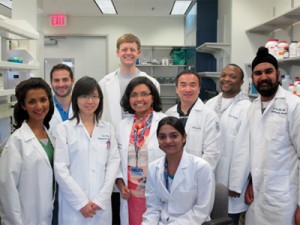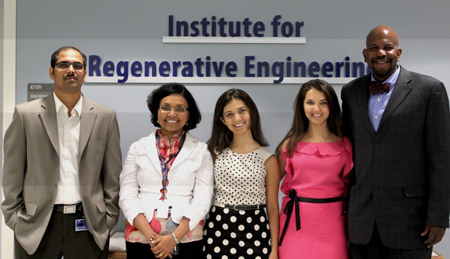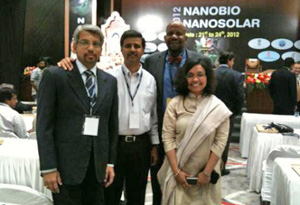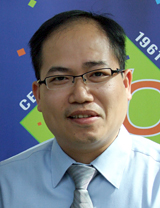 Dr. Nair is an assistant professor who’s been at our institute since its start. She received her education from India. She did her postdoctoral training in my group at Drexel University and the University of Virginia before joining us in her current position. Her research interests include hydrogels, nanotechnology, and tissue engineering. She has more than 50 archival publications in the areas of biomaterials, drug delivery, injectable hydrogels, and tissue engineering.
Dr. Nair is an assistant professor who’s been at our institute since its start. She received her education from India. She did her postdoctoral training in my group at Drexel University and the University of Virginia before joining us in her current position. Her research interests include hydrogels, nanotechnology, and tissue engineering. She has more than 50 archival publications in the areas of biomaterials, drug delivery, injectable hydrogels, and tissue engineering.
Dr. Nair’s current research program in our Institute centers on identifying unique biologically active molecules and developing biofunctional biomaterial constructs as artificial tissue microenvironments which can favorably modulate cellular responses to promote tissue regeneration and/ repair as well as for eliciting host immune defense to promote tumor regression. Their working hypothesis is that bio-functional biomaterials that can activate specific cell signaling pathways can be developed and when appropriately controlled can play a significant role in accelerating tissue regeneration as well as creating an immuno-active microenvironment for tumor regression. Specifically, her approaches to regenerative biomaterials include:
A. Design and Development of bio-functional polymeric systems.
B. Development of injectable biofunctional biomaterials as bioactive artificial cell microenvironment.
C. Understanding the immuno-modulatory functions of biofunctional biomaterials.
D. Understanding the activation of signal transduction pathways in musculoskeletal cells and immune cells in the presence of bio-functional biomaterials.
E. Evaluating the efficacy of the biofunctional biomaterials using in vivo animal models.
Dr. Nair’s laboratory is well-funded and is currently supported by two US-army grants aimed at understanding the immuno-modulatory functions of biofunctional injectable materials and to control their properties to support bone and cartilage tissue regeneration. The research is also funded by CSTC to develop injectable regenerative biomaterials as cell delivery vehicle for bone regeneration. She is the principal investigator on these grants. In addition she is a co-investigator on a Connecticut Stm Cell Institute grant to develop injectable hydrogels for cartilage regeneration using induced pluripotent stem cells (iPSC’s).
Nationally, Dr. Nair is involved in a number of organizations. She is an associate editor of the Journal of Biomaterials and Tissue Engineering and sits on the editorial board for the Recent Patents in Biomedical Engineering and Journal of Biomedical Nanotechnology and serves as a reviewer for more than 30 peer reviewed journals. She also serves on grants panels for federal agencies such as NSF, NIH (adhoc member), Department of Veterans affairs (appointed to the Scientific Merit Review Board) and for international agencies such as Hong Kong Research Grant Council, Israel Science Foundation and Indo-US Science & Technology Forum.

 I was fortunate to be asked to provide a keynote speech for the Second International Conference on Nanotechnology held in Kochi, India. There I was reunited with some of my former students, all of whom are now professors. Swami Sethuranum (left) is the director of the Center for Nanotechnology at SASTRA University near Chennai, India; Dhiru Katti (center) is a leading researcher at the Indian Institute of Technology at Kanpur; and Lakshmi Nair (right) is an outstanding scientist who has been with me since our days at Drexel University in the 1990s. She is currently a core member of the Institute for Regenerative Engineering at the University of Connecticut. All are internationally known for their work in nanotechnology, and all were invited to speak at this conference.
I was fortunate to be asked to provide a keynote speech for the Second International Conference on Nanotechnology held in Kochi, India. There I was reunited with some of my former students, all of whom are now professors. Swami Sethuranum (left) is the director of the Center for Nanotechnology at SASTRA University near Chennai, India; Dhiru Katti (center) is a leading researcher at the Indian Institute of Technology at Kanpur; and Lakshmi Nair (right) is an outstanding scientist who has been with me since our days at Drexel University in the 1990s. She is currently a core member of the Institute for Regenerative Engineering at the University of Connecticut. All are internationally known for their work in nanotechnology, and all were invited to speak at this conference. Dr. Lo is a fellow who’s been in my team since 2008. He was born in Hong Kong and received his Ph.D. degree in Biochemistry from Hong Kong University of Science and Technology. Dr. Lo’s research interests include musculoskeletal tissue engineering, drug delivery, regenerative medicine, biomaterials, biochemistry, and cell molecular biology. Dr. Lo has been an outstanding fellow and it’s been great to have the opportunity to mentor him. His research contributions are reflected in his nineteen papers published in high-impact journals which have been highly cited by other investigators. Dr. Lo submitted several grant applications to funding agencies and two of the applications were recently funded. Dr. Lo also serves as an independent reviewer for a number of international peer-review journals.
Dr. Lo is a fellow who’s been in my team since 2008. He was born in Hong Kong and received his Ph.D. degree in Biochemistry from Hong Kong University of Science and Technology. Dr. Lo’s research interests include musculoskeletal tissue engineering, drug delivery, regenerative medicine, biomaterials, biochemistry, and cell molecular biology. Dr. Lo has been an outstanding fellow and it’s been great to have the opportunity to mentor him. His research contributions are reflected in his nineteen papers published in high-impact journals which have been highly cited by other investigators. Dr. Lo submitted several grant applications to funding agencies and two of the applications were recently funded. Dr. Lo also serves as an independent reviewer for a number of international peer-review journals.